EGYPTOLOGY: Today is the Anniversary of One of the Greatest Discoveries Ever Made
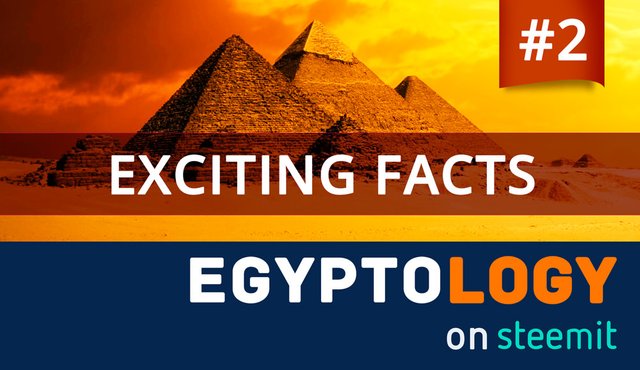
Today is the 4th of November and I want to remind you of a fantastic anniversary: On this day in 1922 – 95 years ago – the tomb of Tutankhamun was discovered by Howard Carter. Many people know the story already and the rumour that his horse accidentally stumbled upon a doorway hidden under the sand is probably a myth. But nevertheless, at least from my perspective, the work of Howard Carter is the most impressive in the History of Egyptology.
When Howard Carter found the entrance to the shaft of the tomb of Tutankhamun, he found chambers that were absolutely untouched. This was very unusual since almost every tomb was already emptied by robbers in antiquities times. In many cases, this happened already a few weeks or month after the funeral and even kings were not safe from the greedy hands of the criminals. Today we assume that the raids were organized by ‘insiders’, which means they were workmen in that area who had access to building plans and a detailed knowledge of a number of treasures and their placement within the tomb shafts. So we can consider ourselves to be extremely lucky when Egyptologists like Howard Carter, who took a long and intensive study on the area before he was successful, could give us this present. In general, from an egyptological perspective, Tutankhamun was not a famous ruler since he died very young and his influence could reach to that height of his predecessors. But the impact his treasures had on the consciousness of humanity is invaluable.
Become a Witness of the Discovery
Do you imagine to go back in time like ‘time traveller’ and witness historical moment like this? It’s almost possible. Here are two amazing examples of re-coloured old photographs that give you, even more, the feeling of having been there in that second when Howard Carter opened the mysterious burial chamber and saw the gold and ebony treasures for the very first time after thousands of years.
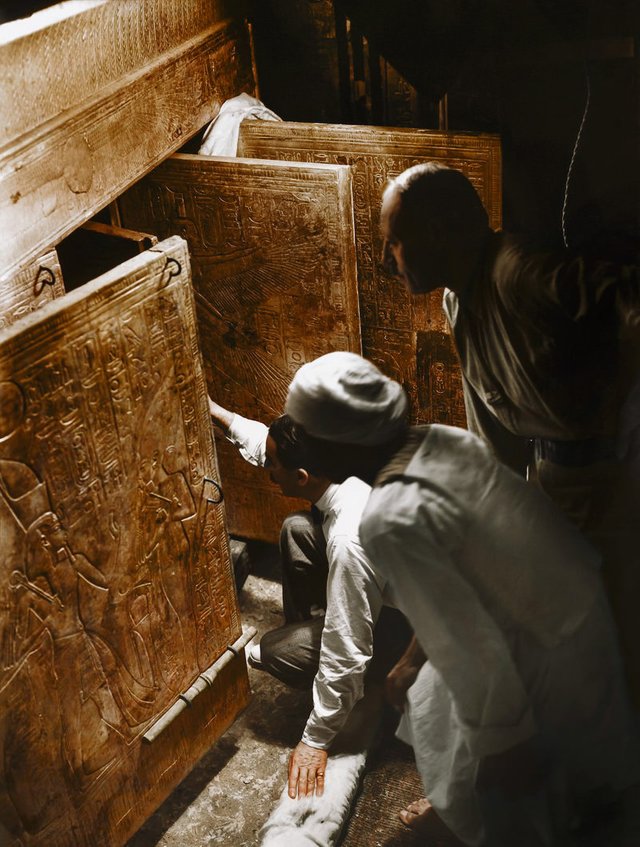
It is told that the funder of the Mission Lord Carnavon asked Carter: ‘Can you see anything?’
And Carter replied: ‘YES, WONDERFUL THINGS!’
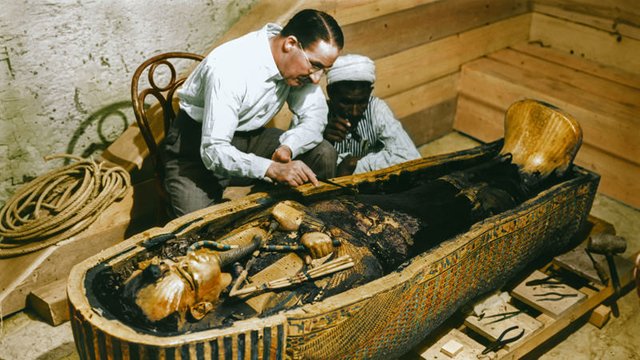
The re-colouring is a complicated technique and was done by Dynamichrome, a company of graphic design experts with breathtaking skills. They have even more amazing pictures on their website and due to copyright restriction which I respect, I can only recommend visiting this page: http://dynamichrome.com/viewfinder/harry-burtons-tutankhamun. I swear you will sit there with big eyes. ;)
Late Fame of an Unknown Ruler
I am very often in the Egyptian Museum in Cairo. And every time when I am there - I first go to ‘Tutti’, just for saying ‘Hello’. I greet a person who had a short life but made many generations thousands of years later very happy. I say ‘happy’ because I think no one can deny the feeling of myth and adventure, and also a bit of honour to the kingship in Ancient Egypt as in general as well. Tutankhamun is the symbol of a highly advanced culture that existed long ago. And since I became an Egyptologist I refuse to talk about a ‘lost’ culture, because as long as we talk about it, nothing is really lost. Even the Ancient Egyptian knew this. They gave things a name and wrote in on their tomb walls to exist in eternity. This culture will never be lost. This is the promise I give to Egypt as an Egyptologist.
Today archaeological excavations are completely different. Nobody would just open a shaft and look into it without a profound research before. I remember one time one of our professors discovered a mummy in a rock tomb within a wooden coffin. Everybody knew that the coffin was not only fragile but quite powdery – when he pulled the wooden planks out of the shaft over his head, parts of the fragmented human remains followed immediately… directly on his face. In this second he had unfortunately opened his mouth. Now you can imagine, what happened. The professor will tell that story until the end of the mission: ‘I ate a mummy.’ But he was cool and laughed at it all the times, but from then on, everybody working in the tomb shafts were obliged to wear dust masks.
Modern Methods of Archaeology
A very new example of advanced archaeology is the discovery of a huge void within the great pyramid of Khufu. But scientist did not open it (yet). They examined the pyramid by most modern technology, the so-called observation by cosmic-ray muons in the Pyramid Scan Projects, which is led by Japanese Archaeologists. The ‘hole’ in the pyramid is now subject to further research and Egyptologists assume that this could possibly be a third chamber. This is controversial discussed already and a fight is going on over the scientific significance of this void. Some scientists say that the pyramids have in general a lot of such voids due to construction inaccuracy. Is it really a burial chamber? We will see.
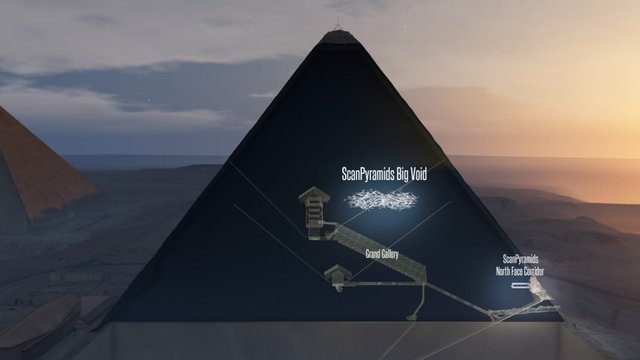
The adventures continue
And also the enigma around the tomb of Tutankhamun is not solved yet. The Egyptologist Nicholas Reeves found anomalies below the paintings on a wall in the burial chamber. His theory was that there were one or more additional chambers behind. And yes, after scanning with modern devices this could be proven right. But they cannot just open that wall because this would cause much damage to the priceless decorations. So the rumours keep going around. Another burial chamber? Maybe of Nefertiti? We will see – for sure!
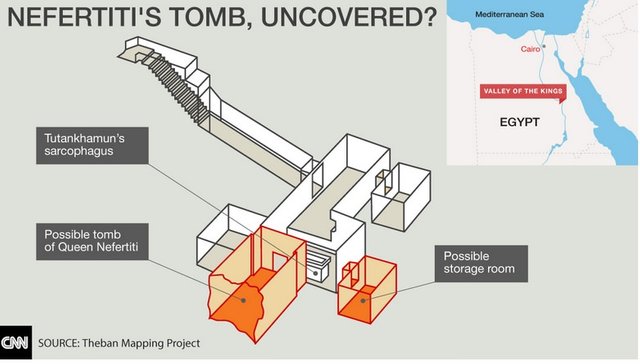
Sources and further reading:
Newberry, P.E., Howard Carter, in: The Journal of Egyptian Archaeology, Vol. 25, No. 1 (Jun., 1939), pp. 67–69. http://www.jstor.org/stable/3854934
Reeves, Nicholas / Taylor, John H., Howard Carter before Tutankhamun. London: 1992, p. 141.
Reeves, Nicholas, The Complete Tutankhamun: The King, the Tomb, the Royal Treasure, London: 1990.
http://www.tutnyc.com
https://www.nature.com/nature/journal/vaap/ncurrent/full/nature24647.html
http://www.sueddeutsche.de/wissen/archaeologie-leere-in-der-pyramide-1.3734056
http://www.sueddeutsche.de/wissen/aegypten-archaeologen-entdecken-hohlraum-in-cheops-pyramide-1.3733079
Images:
Image used in the editorial picture: own photo.
Image 1: © Harry Burton 1922 (Griffith Institute, Oxford); enhanced by Dynamichrome. Source
Image 2: © Harry Burton 1922 (Griffith Institute, Oxford); enhanced by Dynamichrome. Source
Image 3: © dpa, Source
Image 4: ©The Theban Mapping Project, Source
Feel free to ask all the question of what you always wanted to know about Ancient Egypt. That’s my job and my passion. Let’s discuss your thoughts and ideas.

If you liked this article, please follow me on my blog @laylahsophia. I am a german Egyptologist writing about ancient and contemporary Egypt, history of science, philosophy and life.
I have learned new things. Interesting. Great post @laylahsophia.
It will be very interesting as you say to find Nefertiti's tomb. Lets hope it is opened with independent witnesses present because otherwise - stuff will go missing. I suspect like others have mentioned about king 'Tut's'tomb that it was previously tomb raided by Howard Carter, before its official opening with a photographer...
Indeed, that's a rumor that Carter opened it before. I wouldn't be surprised since even back in that times it was all about marketing for such projects. They had to be quite spectacular to get funded.
Carter was funded by Lord Carnarvon a very rich English establishment elite of the times, I bet he got a few gold statues :-)
We may thus hope for special exhibitions in 5 years :)
I loved the stuff with muons. I just learned about it a few days ago on steemit. This is really exciting for a physicist, too ^^
Yeah, it was also completely new to me. We all can learn from each other. :)
Totally :)
liebe @laylahsophia, einfach spannend ohne ende.
in mir wird der kleine junge wach und kriegt solche augen ;-)
p.s.: kleiner hinweis. titel von bild drei und vier sind gleich.
Oh Dankeschön @pawos. Gleichmal geändert. ;)
I too had just watched a video on how they were using Muons to locate chambers in a solid form, and that they have just identified a possible new entrance.
Can't wait for them to open it and see where it goes.
Yes, me too. I am so curious about it!
What an insightful and wonderful post
Thank you. :)
Ein unglaublicher Fund. Als Kind hatte ich ein "Was ist was" Buch darüber und fand es seitdem immer wieder faszinierend. Frage mich, wie viele Dokus ich auf NTV oder NatGeo schon dazu gesehen habe :D
Wirklich toller Post!
Du, ich kann von den Dokus auch nicht genug kriegen, und das, obwohl ich "Ägypten" jeden Tag direkt vor der Nase habe. :D
Das freut mich sehr für dich. Das ist genau das, was viele Menschen suchen und manchmal nicht finden ;)
Here a reproduction of how Tut looked:
Spooky, isn't it? ;))
:O